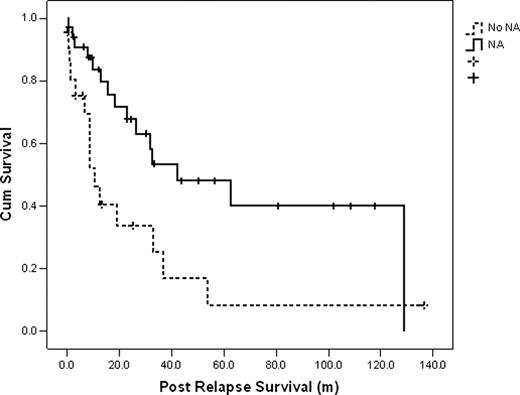Abstract
Abstract 4580
The use of allogeneic hematopoietic stem cell transplant (alloHSCT) in the treatment of Multiple Myeloma (MM) remains controversial. Although there is hope that alloHSCT may result in a cure, relapse continues to be a significant problem. The morbidity associated with late complications of allogeneic transplantation further compounds the issues faced when addressing relapsed disease. The use of Novel Agents (NA) in this patient population has been poorly characterized. Here we present our experience of NA use in patients initially treated with alloHSCT.
108 patients underwent an allografting procedure for their MM at our center between 1989 and 2009. 84 received a fully myeloablative procedure (15 received donor lymphocyte infusion). 24 received an autologous HSCT followed by a reduced intensity allogeneic procedure. 56 have relapsed with this population making up our primary cohort for analysis. 22 patients received NAs and very few patients received them prior to transplant (4/108). Endpoints examined were post relapse survival after the initial HSCT procedure (PRS), overall survival from time of initial treatment (OS) and progression free survival (PFS) measured in months (m).
Of the entire cohort of 108 patients median OS was 78.6m (95% CI; 24.5–132.6). Median PFS was 23.6m (95% CI; 15.4–31.8). Of the non-relapsed patients (n = 52) the median OS was 125.9m. In this cohort 67% of the deaths occurred within 1.5 years. Of the relapsed patients (n = 56) median PFS was 18.7m (95% CI; 14.6–22.8), median PRS was 31.5m (95% CI; 17.0–46.0), and median OS was 67.0m (95% CI; 31.6–102.5). The effect of NA was examined in the cohort of relapsed patients. No significant difference was noted in PFS between those exposed to NA and those who were not exposed (19.0m (95% CI; 10.1–22.8) vs 13.7m (95% CI; 5.8–21.6); p = 0.27). Exposure to NA showed improvements in PRS (42.3m (95% CI; 7.3–77.2) vs 10.4m (95% CI; 5.2–15.7); p = 0.01, Figure 1). A trend toward superior OS was noted (71.4m (95% CI; 37.9–105.5) vs 24.6m (95% CI; 3.0–46.1); p = 0.11) although this did not reach statistical significance.
Ongoing management of relapsed patients with multiple myeloma in the post alloHSCT setting remains a significant challenge. This retrospective study demonstrates that the use of NA is both safe and effective in treating relapsed disease. The predominant impact of these drugs is seen in the relapsed setting. Exposure to NA correlates with a 22m improvement in PRS. A 46m improvement in OS is noted however, likely due to the small cohort, it failed to reach statistical significance.
Kaplan-Meier curve of PRS for patients who received an alloHSCT based on NA exposure.
Kaplan-Meier curve of PRS for patients who received an alloHSCT based on NA exposure.
Sutherland:Celgene: Honoraria; Orthobiotech: Honoraria. Shepherd:Celgene: Honoraria; Orthobiotech: Honoraria. Nevill:Celgene: Honoraria. Toze:Hoffman La Roche: Consultancy, Honoraria, Research Funding; Genzyme: Honoraria, Research Funding; Glaxo Smith Kline: Honoraria.
Author notes
Asterisk with author names denotes non-ASH members.


This feature is available to Subscribers Only
Sign In or Create an Account Close Modal